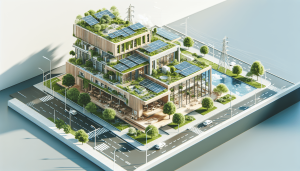In our modern world, embracing sustainable architecture has become more vital than ever. Through this article, we delve into how renewable energy is seamlessly integrated into architectural designs to create eco-friendly, energy-efficient buildings. By exploring innovative methods and cutting-edge technologies, we aim to reveal how architects and engineers are revolutionizing construction practices to mitigate environmental impact. From solar panels to geothermal systems, let’s uncover the ways sustainable architecture is shaping a greener future for all of us. Have you ever wondered how sustainable architecture incorporates renewable energy? We often hear about the importance of sustainability and renewable energy, but the specifics of how these elements come together in construction and design are fascinating. Let’s explore this exciting interplay of innovation and responsibility.
Understanding Sustainable Architecture
Sustainable architecture is an approach to designing and constructing buildings that minimizes the negative environmental impact by utilizing energy-efficient materials and renewable resources. This architectural paradigm not only promotes ecological balance but also aims to improve the quality of life for occupants.
Principles of Sustainable Architecture
Underpinning sustainable architecture are several core principles:
- Energy Efficiency: The design and orientation of buildings often include smart use of windows, insulation, and heating, ventilation, and air conditioning (HVAC) systems.
- Material Selection: Choosing materials that are sustainable, recycled, or have low environmental impact.
- Water Conservation: Implementing systems for natural water filtration, rainwater harvesting, and using water-efficient fixtures.
- Indoor Environmental Quality: Ensuring good air quality, natural lighting, and using non-toxic materials.
- Sustainable Sites: Respecting and preserving the existing environment during and after construction.
Each of these principles plays a critical role in reducing the carbon footprint of buildings and supporting a more sustainable future.
Integrating Renewable Energy into Architecture
Renewable energy integration is a vital aspect of sustainable architecture. By harnessing renewable resources, we can considerably diminish the dependency on fossil fuels and reduce greenhouse gas emissions.
Solar Energy
Solar energy is perhaps the most prevalent renewable energy source incorporated into sustainable buildings. With advancements in solar technology, it’s easier than ever to harness the power of the sun.
Solar Panels and Photovoltaic Systems
Solar panels can be installed on rooftops or integrated into building materials. Photovoltaic systems convert sunlight directly into electricity. For many buildings, these systems can meet, or even exceed, the energy needs without relying on external power grids.
Passive Solar Design
Passive solar design takes advantage of the building’s location and materials to naturally collect and store solar energy. Strategic placement of windows, walls, and floors can maximize natural light and heat, reducing the need for artificial lighting and heating.
Wind Energy
Wind energy is another robust renewable resource. While typically associated with large-scale wind farms, wind turbines are also being adapted for use in urban environments and individual buildings.
Building-Integrated Wind Turbines
Small-scale wind turbines can be incorporated into building designs. They can be placed on rooftops or even integrated into the structure itself. These turbines can generate significant amounts of electricity, especially in regions with high wind potential.
Geothermal Energy
Geothermal energy leverages the constant temperatures beneath the Earth’s surface to provide heating and cooling solutions.
Geothermal Heat Pumps
Geothermal heat pumps transfer heat from the ground into buildings during the winter and reverse the process in the summer. These systems are incredibly efficient and can significantly reduce heating and cooling costs.
Biomass Energy
Biomass energy involves using organic materials such as wood, agricultural residues, and even animal manure to produce energy.
Biomass Boilers
Biomass boilers can be a sustainable alternative to conventional heating systems. They burn organic material to generate heat for water and space heating.
Hydro Energy
Hydropower is commonly associated with large dams, but small-scale hydro solutions can be adapted for individual buildings or communities.
Micro-Hydro Systems
Micro-hydro systems harness the energy of flowing water from nearby streams or rivers to generate electricity. These systems are ideal for rural or off-grid locations with access to running water.

Advantages of Renewable Energy in Sustainable Architecture
Incorporating renewable energy into sustainable architecture offers numerous benefits. These not only extend to environmental sustainability but also provide economic and social advantages.
Environmental Benefits
- Reduced Carbon Emissions: By decreasing reliance on fossil fuels, renewable energy sources substantially lower greenhouse gas emissions.
- Lower Energy Consumption: Enhanced energy efficiency leads to reduced overall energy consumption.
- Resource Sustainability: Using renewable resources prevents the depletion of non-renewable materials.
Economic Benefits
- Cost Savings: Over time, the use of renewable energy can lead to significant savings on energy bills.
- Job Creation: The renewable energy sector is burgeoning, creating numerous job opportunities in energy production, system installation, and maintenance.
- Energy Independence: Utilizing local renewable resources can reduce dependence on imported energy.
Social Benefits
- Improved Health: Reducing fossil fuel combustion decreases air pollution, leading to better public health outcomes.
- Energy Security: Renewable energy can provide reliable power, especially in regions where access to conventional energy is limited.
- Enhanced Quality of Life: Buildings designed with renewable energy integration often offer superior living conditions, with better air quality and reduced energy costs.
Challenges in Incorporating Renewable Energy
While the benefits of incorporating renewable energy into sustainable architecture are clear, there are several challenges that must be addressed.
Initial Costs
The initial investment required for renewable energy systems can be high. Although long-term savings are substantial, the upfront costs can be a barrier for many projects.
Technological Limitations
While technology is advancing rapidly, there are still limitations. For instance, solar panels may be less effective in areas with low sunlight, and wind turbines require specific conditions to be efficient.
Space Requirements
Some renewable energy systems, like wind turbines and solar panels, require significant space, which can be a limiting factor in urban environments.
Intermittency
Renewable energy sources like solar and wind can be intermittent, depending on weather conditions. Energy storage solutions or hybrid systems are often necessary to ensure a reliable power supply.

Success Stories and Case Studies
Let’s look at some real-world examples of successful renewable energy integration in sustainable architecture.
The Bullitt Center, Seattle
Often referred to as the “greenest commercial building in the world,” the Bullitt Center incorporates numerous sustainable features. Solar panels on the roof provide all the building’s electricity needs, while a geothermal heat pump system offers efficient heating and cooling.
Bosco Verticale, Milan
Bosco Verticale, or the Vertical Forest, is a pair of residential towers featuring a lush array of trees and shrubs integrated into the architecture. Solar panels and wind turbines supplement the buildings’ energy needs, and the vegetation contributes to better air quality, natural cooling, and reduced noise pollution.
One Central Park, Sydney
One Central Park in Sydney is renowned for its vertical gardens and innovative use of renewable energy. The development includes a tri-generation plant that produces thermal and electrical energy, solar panels, and a central thermal plant for heating and cooling.
Future Trends in Renewable Energy and Sustainable Architecture
The field of sustainable architecture is dynamic, continually evolving with new technologies and methodologies. Exciting trends are emerging that promise to revolutionize how we harness renewable energy.
Smart Buildings
Smart buildings use advanced technologies to optimize energy usage. Internet of Things (IoT) devices can manage various building systems (lighting, HVAC, security) for energy efficiency and occupant comfort.
Energy-Positive Buildings
Energy-positive buildings generate more energy than they consume. Innovations in design, material science, and renewable energy systems make this increasingly achievable.
| Feature | Description |
|---|---|
| Solar Energy Integration | Extensive use of solar panels to exceed energy needs |
| Advanced Insulation | High-performance materials to minimize energy loss |
| Energy Storage Solutions | Batteries and other systems to store excess energy |
Urban Wind Harvesting
In urban environments, architects are looking at ways to efficiently incorporate wind energy. Building-integrated wind turbines and specialized wind-harvesting structures are leading this innovation.
Building Materials with Energy Production
Photovoltaic glass and other materials that generate energy are becoming more common. These materials can be used in windows, skylights, and facades, turning entire buildings into energy generators.

Conclusion
The integration of renewable energy in sustainable architecture is not just a trend but a critical step toward a greener and more resilient future. By exploring and embracing various renewable energy sources, we can build structures that are not only environmentally friendly but also economically viable and socially beneficial.
Together, through continued innovation and dedication to sustainability, we can create buildings that harmonize with the planet and support a thriving human presence for generations to come. If you’ve ever wondered how sustainable architecture incorporates renewable energy, now you know: it’s through a combination of smart design, cutting-edge technology, and a commitment to better living.
Let’s continue to support and develop these practices, nurturing a sustainable world with every brick we lay and every solar panel we install.



